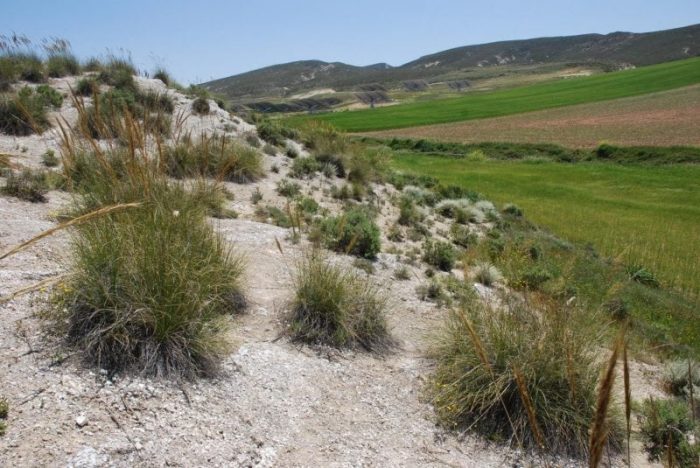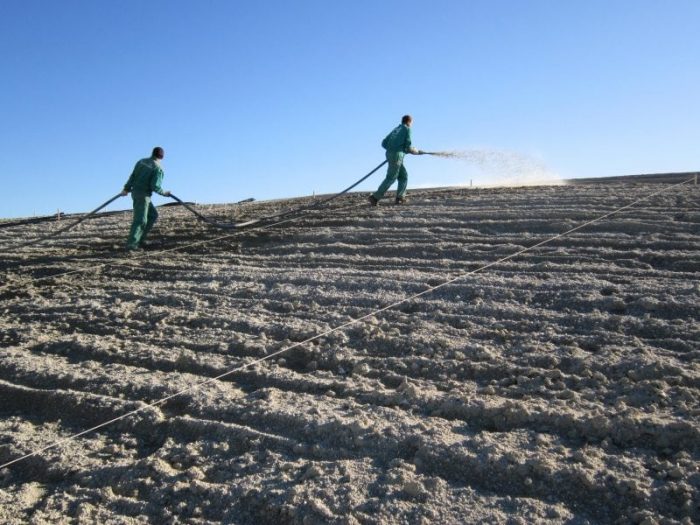
Quarrying usually inflicts a heavy impact on ecosystems by altering both topography and soil properties and removing the vegetation. This disturbance affects the habitat of several plant species, some exclusively associated with the minerals extracted (e.g. serpentine, dolomites, gypsum).
Gypsum soils in drylands worldwide are often important habitats for plant conservation, supporting flora with many rare and endemic species specialized to live on these substrates (i.e. gypsicolous flora) that are protected at different scales. However, gypsum is a mineral used in the building industry and is in global demand. Its extraction through mining damages the valuable gypsicolous vegetation and the habitat. Although mining companies are frequently required to conduct restorative actions, there is almost no information on the most appropriate ecological restoration techniques.
Without restoration, spontaneous recovery of gypsicolous vegetation may take decades or not occur at all due to limiting site-specific conditions, such as unstable and unsuitable substrates generated by quarrying, the lack of propagules, or competition with generalist species. Aided recovery through active measures such as planting and sowing can provide good restoration of gypsicolous vegetation, but they are mainly used on relatively flat landforms.
Gypsum quarrying often generates waste areas with steep slopes. One way to tackle steep slopes restoration is through hydroseeding. Hydroseeding consists of spraying a slurry of seed and mulch from vehicle-mounted tanks onto the area to be restored and is frequently used to reach inaccessible sites, such as steep slopes. Although hydroseeding is widely used in quarry and road-side rehabilitation, there are no specific guidelines to design restoration programs for disturbed gypsum habitats.

Credit: The Authors
With this research, we wanted to go further and test the applicability of various hydroseeding options to recover gypsicolous vegetation on spoil slopes generated by quarrying under dry Mediterranean conditions in Granada, southeast Spain. Our hypothesis was that vegetation response would be determined by the hydroseeding method, slope, and site aspect in experimental slopes built ad-hoc with gypsum spoil.
We assessed three hydroseeding treatments: paper cellulose mulch, paper cellulose mulch + organic blanket (organic blankets are commonly used for erosion control), and wood fiber mulch, and these were compared against a control where no hydroseeding was conducted. These treatments were tested on two slopes (shallow, 10-15%, vs. steep, 60-65%) and two contrasting aspects (north vs. south). We evaluated the vegetation cover 2.8 years after treatment, assessing both target gypsicolous species and non-target species (i.e., colonizing generalist species).
Target species included three species exclusive to gypsum soils (i.e. gypsophiles): Helianthemum squamatum and Lepidium subulatum (widely distributed in gypsum outcrops in Spain) and the narrow endemic Ononis tridentata subsp. crassifolia restricted to gypsum outcrops in the CW Granada province. Additionally, we included other species in the gypsum habitat in the area, such as rosemary (Rosmarinus officinalis), alpha-grass (Stipa tenacisssima) and thyme (Thymus zygis), as well as the germander (Teucrium capitatum) and rockrose (Helianthemum syriacum) species.
Our experiments in quarry slopes showed restoration was very recommendable. In contrast to control plots, all hydroseeding treatments improved target vegetation remarkably, although they did with different effectiveness. The wood fiber was effective in most situations studied, although good alternatives were the paper mulch on shallow slopes (cheaper but less effective), or the paper mulch + blanket on steep slopes (more expensive but convenient in case of high erosion risk). As could be expected, the success of hydroseeding methods was lower in steep slopes. This could be attributed to higher runoff and the fact that erosion can remove more seeds there than in shallow slopes.

Credit: The Authors
However, the recovery of target vegetation was satisfactory on shallow and on southern steep slopes, but not on northern steep slopes where, interestingly, non-target species developed more readily. The lower insolation at this latitude on steep, northern slopes appears to reduce physical and water limitations, allowing generalist colonizing species to outcompete target species, which normally have less competition under the harsh and dry conditions of gypsum substrates.
Our results highlight the importance of understanding the factors influencing establishment patterns of target vegetation in restoration actions. Minimizing quarry slopes when possible, selecting the most appropriate hydroseeding treatment, and avoiding northern-steep slopes can help to maximize efforts and cost-effectiveness in the restoration of gypsicolous vegetation. These results can be very useful and will help to guide restoration of gypsicolous vegetation in disturbed gypsum habitats.
These findings are described in the article entitled Restoration of gypsicolous vegetation on quarry slopes: Guidance for hydroseeding under contrasting inclination and aspect published in the journal Land Degradation & Development. The work was conducted by Miguel Ballesteros, Eva Cañadas, Rob H. Marrs, Ana Foronda, Francisco Martín-Peinado and Juan Lorite from the University of Granada and the University of Liverpool.








